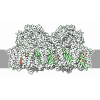+ Open data
Open data
- Basic information
Basic information
| Entry | Database: PDB / ID: 7nhq | ||||||||||||
|---|---|---|---|---|---|---|---|---|---|---|---|---|---|
| Title | Structure of PSII-I prime (PSII with Psb28, and Psb34) | ||||||||||||
 Components Components |
| ||||||||||||
 Keywords Keywords | PHOTOSYNTHESIS / Membrane Protein Biogenesis Assembly Factors Photosystem II | ||||||||||||
| Function / homology |  Function and homology information Function and homology informationphotosystem II oxygen evolving complex / oxygen evolving activity / photosystem II stabilization / photosystem II reaction center / photosystem II / oxidoreductase activity, acting on diphenols and related substances as donors, oxygen as acceptor / photosynthetic electron transport chain / photosystem II / response to herbicide / chlorophyll binding ...photosystem II oxygen evolving complex / oxygen evolving activity / photosystem II stabilization / photosystem II reaction center / photosystem II / oxidoreductase activity, acting on diphenols and related substances as donors, oxygen as acceptor / photosynthetic electron transport chain / photosystem II / response to herbicide / chlorophyll binding / plasma membrane-derived thylakoid membrane / photosynthetic electron transport in photosystem II / photosynthesis, light reaction / phosphate ion binding / : / photosynthesis / electron transfer activity / protein stabilization / iron ion binding / heme binding / metal ion binding Similarity search - Function | ||||||||||||
| Biological species |   Thermosynechococcus elongatus BP-1 (bacteria) Thermosynechococcus elongatus BP-1 (bacteria) | ||||||||||||
| Method | ELECTRON MICROSCOPY / single particle reconstruction / cryo EM / Resolution: 2.68 Å | ||||||||||||
 Authors Authors | Zabret, J. / Bohn, S. / Schuller, S.K. / Arnolds, O. / Chan, A. / Tajkhorshid, E. / Stoll, R. / Engel, B.D. / Rudack, T. / Schuller, J.M. / Nowaczyk, M.M. | ||||||||||||
| Funding support |  Germany, 3items Germany, 3items
| ||||||||||||
 Citation Citation |  Journal: Nat Plants / Year: 2021 Journal: Nat Plants / Year: 2021Title: Structural insights into photosystem II assembly. Authors: Jure Zabret / Stefan Bohn / Sandra K Schuller / Oliver Arnolds / Madeline Möller / Jakob Meier-Credo / Pasqual Liauw / Aaron Chan / Emad Tajkhorshid / Julian D Langer / Raphael Stoll / Anja ...Authors: Jure Zabret / Stefan Bohn / Sandra K Schuller / Oliver Arnolds / Madeline Möller / Jakob Meier-Credo / Pasqual Liauw / Aaron Chan / Emad Tajkhorshid / Julian D Langer / Raphael Stoll / Anja Krieger-Liszkay / Benjamin D Engel / Till Rudack / Jan M Schuller / Marc M Nowaczyk /    Abstract: Biogenesis of photosystem II (PSII), nature's water-splitting catalyst, is assisted by auxiliary proteins that form transient complexes with PSII components to facilitate stepwise assembly events. ...Biogenesis of photosystem II (PSII), nature's water-splitting catalyst, is assisted by auxiliary proteins that form transient complexes with PSII components to facilitate stepwise assembly events. Using cryo-electron microscopy, we solved the structure of such a PSII assembly intermediate from Thermosynechococcus elongatus at 2.94 Å resolution. It contains three assembly factors (Psb27, Psb28 and Psb34) and provides detailed insights into their molecular function. Binding of Psb28 induces large conformational changes at the PSII acceptor side, which distort the binding pocket of the mobile quinone (Q) and replace the bicarbonate ligand of non-haem iron with glutamate, a structural motif found in reaction centres of non-oxygenic photosynthetic bacteria. These results reveal mechanisms that protect PSII from damage during biogenesis until water splitting is activated. Our structure further demonstrates how the PSII active site is prepared for the incorporation of the MnCaO cluster, which performs the unique water-splitting reaction. | ||||||||||||
| History |
|
- Structure visualization
Structure visualization
| Movie |
 Movie viewer Movie viewer |
|---|---|
| Structure viewer | Molecule:  Molmil Molmil Jmol/JSmol Jmol/JSmol |
- Downloads & links
Downloads & links
- Download
Download
| PDBx/mmCIF format |  7nhq.cif.gz 7nhq.cif.gz | 472 KB | Display |  PDBx/mmCIF format PDBx/mmCIF format |
|---|---|---|---|---|
| PDB format |  pdb7nhq.ent.gz pdb7nhq.ent.gz | 396 KB | Display |  PDB format PDB format |
| PDBx/mmJSON format |  7nhq.json.gz 7nhq.json.gz | Tree view |  PDBx/mmJSON format PDBx/mmJSON format | |
| Others |  Other downloads Other downloads |
-Validation report
| Summary document |  7nhq_validation.pdf.gz 7nhq_validation.pdf.gz | 4 MB | Display |  wwPDB validaton report wwPDB validaton report |
|---|---|---|---|---|
| Full document |  7nhq_full_validation.pdf.gz 7nhq_full_validation.pdf.gz | 4.2 MB | Display | |
| Data in XML |  7nhq_validation.xml.gz 7nhq_validation.xml.gz | 96.2 KB | Display | |
| Data in CIF |  7nhq_validation.cif.gz 7nhq_validation.cif.gz | 128 KB | Display | |
| Arichive directory |  https://data.pdbj.org/pub/pdb/validation_reports/nh/7nhq https://data.pdbj.org/pub/pdb/validation_reports/nh/7nhq ftp://data.pdbj.org/pub/pdb/validation_reports/nh/7nhq ftp://data.pdbj.org/pub/pdb/validation_reports/nh/7nhq | HTTPS FTP |
-Related structure data
| Related structure data |  12337MC  7nhoC  7nhpC M: map data used to model this data C: citing same article ( |
|---|---|
| Similar structure data |
- Links
Links
- Assembly
Assembly
| Deposited unit | 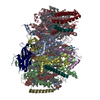
|
|---|---|
| 1 |
|
- Components
Components
-Photosystem II ... , 14 types, 14 molecules ABCDHIKLMTXyZ2
| #1: Protein | Mass: 39762.309 Da / Num. of mol.: 1 / Source method: isolated from a natural source Source: (natural)   Thermosynechococcus elongatus BP-1 (bacteria) Thermosynechococcus elongatus BP-1 (bacteria)References: UniProt: P0A444, photosystem II |
|---|---|
| #2: Protein | Mass: 56656.457 Da / Num. of mol.: 1 / Source method: isolated from a natural source Source: (natural)   Thermosynechococcus elongatus BP-1 (bacteria) Thermosynechococcus elongatus BP-1 (bacteria)References: UniProt: Q8DIQ1 |
| #3: Protein | Mass: 50287.500 Da / Num. of mol.: 1 / Source method: isolated from a natural source Source: (natural)   Thermosynechococcus elongatus BP-1 (bacteria) Thermosynechococcus elongatus BP-1 (bacteria)References: UniProt: Q8DIF8 |
| #4: Protein | Mass: 39388.156 Da / Num. of mol.: 1 / Source method: isolated from a natural source Source: (natural)   Thermosynechococcus elongatus BP-1 (bacteria) Thermosynechococcus elongatus BP-1 (bacteria)References: UniProt: Q8CM25, photosystem II |
| #7: Protein | Mass: 7358.754 Da / Num. of mol.: 1 / Source method: isolated from a natural source Source: (natural)   Thermosynechococcus elongatus BP-1 (bacteria) Thermosynechococcus elongatus BP-1 (bacteria)References: UniProt: Q8DJ43 |
| #8: Protein/peptide | Mass: 4410.245 Da / Num. of mol.: 1 / Source method: isolated from a natural source Source: (natural)   Thermosynechococcus elongatus BP-1 (bacteria) Thermosynechococcus elongatus BP-1 (bacteria)References: UniProt: Q8DJZ6 |
| #9: Protein/peptide | Mass: 5028.083 Da / Num. of mol.: 1 / Source method: isolated from a natural source Source: (natural)   Thermosynechococcus elongatus BP-1 (bacteria) Thermosynechococcus elongatus BP-1 (bacteria)References: UniProt: Q9F1K9 |
| #10: Protein/peptide | Mass: 4299.044 Da / Num. of mol.: 1 / Source method: isolated from a natural source Source: (natural)   Thermosynechococcus elongatus BP-1 (bacteria) Thermosynechococcus elongatus BP-1 (bacteria)References: UniProt: Q8DIN8 |
| #11: Protein/peptide | Mass: 3981.673 Da / Num. of mol.: 1 / Source method: isolated from a natural source Source: (natural)   Thermosynechococcus elongatus BP-1 (bacteria) Thermosynechococcus elongatus BP-1 (bacteria)References: UniProt: Q8DHA7 |
| #12: Protein/peptide | Mass: 3878.728 Da / Num. of mol.: 1 / Source method: isolated from a natural source Source: (natural)   Thermosynechococcus elongatus BP-1 (bacteria) Thermosynechococcus elongatus BP-1 (bacteria)References: UniProt: Q8DIQ0 |
| #13: Protein/peptide | Mass: 4322.226 Da / Num. of mol.: 1 / Source method: isolated from a natural source Source: (natural)   Thermosynechococcus elongatus BP-1 (bacteria) Thermosynechococcus elongatus BP-1 (bacteria)References: UniProt: Q9F1R6 |
| #14: Protein/peptide | Mass: 5039.143 Da / Num. of mol.: 1 / Source method: isolated from a natural source Source: (natural)   Thermosynechococcus elongatus BP-1 (bacteria) Thermosynechococcus elongatus BP-1 (bacteria)References: UniProt: Q8DJI1 |
| #15: Protein | Mass: 6766.187 Da / Num. of mol.: 1 / Source method: isolated from a natural source Source: (natural)   Thermosynechococcus elongatus BP-1 (bacteria) Thermosynechococcus elongatus BP-1 (bacteria)References: UniProt: Q8DHJ2 |
| #16: Protein | Mass: 13188.769 Da / Num. of mol.: 1 / Source method: isolated from a natural source Source: (natural)   Thermosynechococcus elongatus BP-1 (bacteria) Thermosynechococcus elongatus BP-1 (bacteria)References: UniProt: Q8DLJ8 |
-Cytochrome b559 subunit ... , 2 types, 2 molecules EF
| #5: Protein | Mass: 9580.840 Da / Num. of mol.: 1 / Source method: isolated from a natural source Source: (natural)   Thermosynechococcus elongatus BP-1 (bacteria) Thermosynechococcus elongatus BP-1 (bacteria)References: UniProt: Q8DIP0 |
|---|---|
| #6: Protein/peptide | Mass: 5067.900 Da / Num. of mol.: 1 / Source method: isolated from a natural source Source: (natural)   Thermosynechococcus elongatus BP-1 (bacteria) Thermosynechococcus elongatus BP-1 (bacteria)References: UniProt: Q8DIN9 |
-Protein , 1 types, 1 molecules 3
| #17: Protein | Mass: 5943.893 Da / Num. of mol.: 1 / Source method: isolated from a natural source Source: (natural)   Thermosynechococcus elongatus BP-1 (bacteria) Thermosynechococcus elongatus BP-1 (bacteria)References: UniProt: Q8DMP8 |
|---|
-Non-polymers , 10 types, 60 molecules 



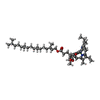
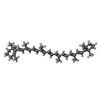
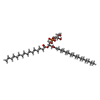
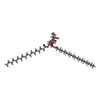
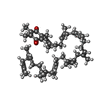










| #18: Chemical | ChemComp-FE / | ||||||||||||
|---|---|---|---|---|---|---|---|---|---|---|---|---|---|
| #19: Chemical | ChemComp-MN / | ||||||||||||
| #20: Chemical | ChemComp-CL / | ||||||||||||
| #21: Chemical | | #22: Chemical | ChemComp-CLA / #23: Chemical | ChemComp-BCR / #24: Chemical | ChemComp-LHG / | #25: Chemical | ChemComp-LMG / #26: Chemical | ChemComp-PL9 / | #27: Chemical | ChemComp-HEM / | |
-Details
| Has ligand of interest | N |
|---|
-Experimental details
-Experiment
| Experiment | Method: ELECTRON MICROSCOPY |
|---|---|
| EM experiment | Aggregation state: PARTICLE / 3D reconstruction method: single particle reconstruction |
- Sample preparation
Sample preparation
| Component | Name: PSII-I prime / Type: COMPLEX / Entity ID: #1-#17 / Source: NATURAL |
|---|---|
| Molecular weight | Experimental value: NO |
| Source (natural) | Organism:   Thermosynechococcus elongatus BP-1 (bacteria) Thermosynechococcus elongatus BP-1 (bacteria) |
| Buffer solution | pH: 6.5 |
| Specimen | Embedding applied: NO / Shadowing applied: NO / Staining applied: NO / Vitrification applied: YES |
| Vitrification | Cryogen name: ETHANE-PROPANE |
- Electron microscopy imaging
Electron microscopy imaging
| Experimental equipment |  Model: Titan Krios / Image courtesy: FEI Company |
|---|---|
| Microscopy | Model: FEI TITAN KRIOS |
| Electron gun | Electron source:  FIELD EMISSION GUN / Accelerating voltage: 300 kV / Illumination mode: FLOOD BEAM FIELD EMISSION GUN / Accelerating voltage: 300 kV / Illumination mode: FLOOD BEAM |
| Electron lens | Mode: BRIGHT FIELD |
| Image recording | Electron dose: 55 e/Å2 / Film or detector model: GATAN K3 (6k x 4k) |
- Processing
Processing
| CTF correction | Type: PHASE FLIPPING AND AMPLITUDE CORRECTION |
|---|---|
| 3D reconstruction | Resolution: 2.68 Å / Resolution method: FSC 0.143 CUT-OFF / Num. of particles: 91479 / Symmetry type: POINT |
 Movie
Movie Controller
Controller







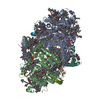

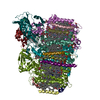
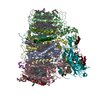

 PDBj
PDBj